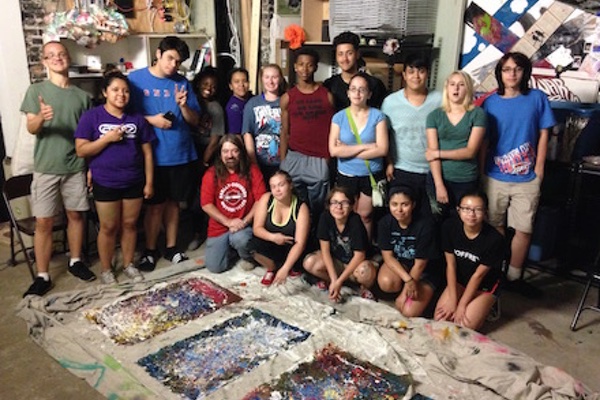From Accident to Environmental Art Movement
by Emily Jaeger, Features Editor

According to Lisa Levasseur, the founder of PaletteArt, the movement began as a fruitful accident: “When I painted my first acrylic painting, I was mixing too much paint and it would dry before I could use it all. So, I chipped it off my palette and created a collage on canvas with all the bits and pieces.” Over the next few months, she experimented with multiple techniques of repurposing old paint, including combining it with other products, “sculpting, grinding, or chopping it up,” even adding it to fresh paint. (See Levasseur’s work in WTP Vol. IV #5.)
The methods of recycling paint in her own art proved limitless. Yet, as Levasseur exhibited her recycled artwork alongside other internationally renowned artists, she soon realized that she could grow PaletteArt into an environmental as well as art movement: “Through PaletteArt, we have begun helping other artists to recycle paint [and] teach these techniques.” By promoting the recycling of paint within the art community, PaletteArt could facilitate a reduction of toxic chemicals in landfills.
Open to all, participating artists not only learn how to repurpose paint, but are also allotted free multi-media promotion on the PaletteArt website and other venues; are able to network with other influential visual artists; and gain free access to stellar resources such as juried contests and scholarship opportunities.

Brian Rock, a painter, combat veteran, and PaletteArt instructor, originally joined the movement because of its potential for emerging artists:
A lot of new and aspiring artists are hindered financially when it comes to obtaining the materials that they need in order to produce. Creativity should not come under any burdens or restrictions, and the artist needs to be able to experiment and ultimately grow.”
Rock collects used paint not only from landfills, but from a network of painting contractors and car dealerships. He applies multiple methods for repurposing this discarded paint, including straight pour, thinning paint from landfills, melting hardened paint, and cutting open acrylic tubes discarded by other artists. PaletteArt significantly reduced Rock’s financial burden as an artist: “I have exhibited in Paris, London, Vienna, Florence, Venice, Barcelona, and on both coasts of the US, and I have not bought paint from an art shop in three years!”

PaletteArt has had a profound influence on Rock’s artistic process. As a combat veteran, Rock had always been intrigued by the “persistence of memory.” Recycling was the perfect metaphor for exploring this issue. Playground, a piece inspired by the plight of children in war zones, is comprised of the ashes from Rock’s previous paintings depicting his own war memories. The piece also incorporates a mixed-medium of recycled elements including bullet casings, nails, dirt, ash, wire, glass, and textiles. Rock writes, “I am recycling my old memories into new ones.”
Copyright 2016 Woven Tale Press LLC. All Rights Reserved.

